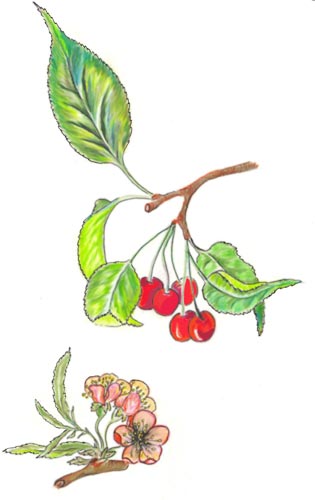Relatives
Cerasus glandulosa (Thunb.) Loisel. - Almond cherry.
Taxonomic position.
Family Rosaceae Juss. genus Cerasus Hill.Synonyms.
Microcerasus humilis (Bunge) Roem, Prunus glandulosa Thunb., P. japonica var. glandulosa Maxim., Cerasus japonica var. glandulosa (Maxim.) Kom. et Aliss.Morphology and biology.
Plant is a shrub up to 1 (1.5) m tall, with light-gray or sometimes brown branches. Young shoots are reddish-brown, often glaucous, thin. Buds have broad obtuse scales; inner ones are glandular along the edge. Leaves are 3-7 cm long and 1.7-3 cm wide, varying in shape from ovate to oblong and lanceolate, gradually or abruptly tapered into a long sharp point, finely dentate along the edge, sometimes doubly adenodentate, naked or covered with sparse hairs from above and pilose only along the main vein from below. Petioles are 2-7 mm long, without glandules. Flowers are solitary or grouped in umbels of 2 or 3, set on naked or slightly adenotrichous pedicels that are 1-2 cm long. Flowers open simultaneously with leaves or a little earlier. When plant begins to blossom, blossoms are red, but later turn pink or less frequently white, reaching 1.5-2 cm in diameter. Hypanthium is broadly bell-shaped. Sepals are 3-5 mm long, adenodentate, deflected. Fruits are 1 (1.2) cm in diameter, dark-red, globular, edible. Stones vary from almost spherical to obovoid, acuminate, with faintly expressed striation. Entomophilous. Ornito- and zoochore. Plant is propagated by seed and summer cuttings. Seed require stratification for 4-5 months at 1-5 degrees Centigrade. Blossoms in May, bears fruit in August. 2n=16.Distribution.
Grows throughout the Russian Far East (south of Maritime Region); China, Korea and Japan.Ecology.
Mesophyte. Photophilous. Plant is drought-resistant. It grows as solitary plants or in small groups on dry stony mountainsides among shrubby thickets and in river valleys on dry and non-flooded sites.Utilization and economic value.
Plant is used as food (fruit), ornamental and as a nectariferous species. This species is close to the Chinese cherry (Cerasus japonica (Thunb.) Loisel.) and has been cultivated in Japan since early times. Used for breeding new dwarf and frost-resistance varieties. Among cultivated forms there is a very ornamental one with double pink flowers.Reference citations:
Brezhnev D.D., Korovina O.N. 1981. Wild relatives of cultivated plants in the flora of the USSR. Leningrad: Kolos. 180 p. (In Russian)Koropachinskiy I.Yu., Vstovskaya T.N. 2002. Woody plants of the Asian part of Russia. Novosibirsk: Publishing House of SB RAS, Branch "Geo". 301-302 pp. (In Russian)
Poyarkova, A.I. 1941. Cherry-Cerasus Hill. Flora of the USSR. V. 10. Moscow-Leningrad: Publishing House of the USSR Academy of Sciences. 562-563 pp. (In Russian)


